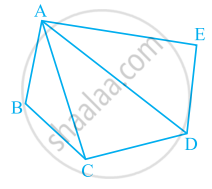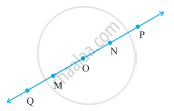Advertisements
Advertisements
प्रश्न
Answer the questions with the help of a given figure.

- State the points which are equidistant from point B.
- Write a pair of points equidistant from point Q.
- Find d(U, V), d(P, C), d(V, B), d(U, L).
उत्तर
(i) The co-ordinates of points B and C are 2 and 4 respectively.
We know that 4 > 2
∴ d(B, C) = 4 − 2
∴ d(B, C) = 2
The co-ordinates of points B and A are 2 and 0 respectively.
We know that 2 > 0
∴ d(B, A) = 2 − 0
∴ d(B, A) = 2
Since d(B, A) = d(B, C), then points A and C are equidistant from point B.
The co-ordinates of points B and D are 2 and 6 respectively.
We know that 6 > 2
∴ d(B, D) = 6 − 2
∴ d(B, D) = 4
The co-ordinates of points B and P are 2 and −2 respectively.
We know that 2 > − 2
∴ d(B, P) = 2 − (− 2)
∴ d(B, P) = 2 + 2
∴ d(B, P) = 4
Since d(B, D) = d(B, P), then points D and P are equidistant from point B.
(ii) The co-ordinates of points Q and U are −4 and −5 respectively.
We know that −4 > −5
∴ d(Q, U) = − 4 − (− 5)
∴ d(Q, U) = − 4 + 5
∴ d(Q, U) = 1
The co-ordinates of points Q and L are −4 and −3 respectively.
We know that − 3 > − 4
∴ d(Q, L) = −3 − (− 4)
∴ d(Q, L) = −3 + 4
∴ d(Q, L) = 1
Since d(Q, U) = d(Q, L), then points U and L are equidistant from point Q.
The co-ordinates of points Q and R are −4 and −6 respectively.
We know that − 4 > − 6
∴ d(Q, R) = −4 − (−6)
∴ d(Q, R) = −4 + 6
∴ d(Q, R) = 2
The co-ordinates of points Q and P are −4 and −2 respectively.
We know that −2 > − 4
∴ d(Q, P) = −2 − (− 4)
∴ d(Q, P) = −2 + 4
∴ d(Q, P) = 2
Since d(Q, R) = d(Q, P), then points R and P are equidistant from point Q.
(iii) The co-ordinates of points U and V are −5 and 5 respectively.
We know that 5 > − 5
∴ d(U, V) = 5 − (− 5)
∴ d(U, V) = 5 + 5
∴ d(U, V) = 10
The co-ordinates of points P and C are −2 and 4 respectively.
We know that 4 > −2
∴ d(P, C) = 4 − (− 2)
∴ d(P, C) = 4 + 2
∴ d(P, C) = 6
The co-ordinates of points V and B are 5 and 2 respectively.
We know that 5 > 2
∴ d(V, B) = 5 − 2
∴ d(V, B) = 3
The co-ordinates of points U and L are −5 and −3 respectively.
We know that − 3 > − 5
∴ d(U, L) = −3 − (−5)
∴ d(U, L) = −3 + 5
∴ d(U, L) = 2
APPEARS IN
संबंधित प्रश्न
A line segment from point ‘B’ to point ‘A’ is denoted by _____________
Name the vertices and the line segments in figure.
Which points in figure, appear to be mid-points of the line segments? When you locate a mid-point, name the two equal line segments formed by it.
Which points in figure, appear to be mid-points of the line segments? When you locate a mid-point, name the two equal line segments formed by it.
Is it possible for the same angle to have two different measures?
Will the measure of ∠ABC and of ∠CBD make measure of ∠ABD in figure?
In given figure how many line segments are there? Name them.
Consider the following figure of line \[\overleftrightarrow{MN}\]. Say whether the following statement is true or false in the context of the given figure.

M is one of the end points of line segment `overline"QO"`.
Write the names of six line segments.

The following table shows points on a number line and their co-ordinates. Decide whether the pair of segments given below the table are congruent or not.
| Point | A | B | C | D | E |
| Co-ordinate | -3 | 5 | 2 | -7 | 9 |
seg BC and seg AD
